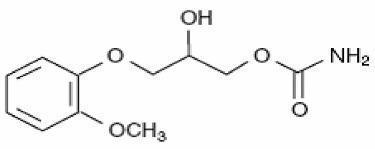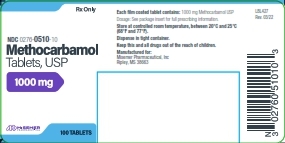METHOCARBAMOL tablet, coated
Methocarbamol by
Drug Labeling and Warnings
Methocarbamol by is a Prescription medication manufactured, distributed, or labeled by Misemer Pharmaceutical . Drug facts, warnings, and ingredients follow.
Drug Details [pdf]
-
DESCRIPTION
Methocarbamol Tablets USP,1000 mg, a carbamate derivative of gualfenesin, is a central nervous system (CNS) depressant with sedative and musculoskeletal relaxant properties.
The chemical name of methocarbamol is a 3-(2 methoxyphenoxy)-1,2-propanediol 1-carbamate and has the empirical formula C11H15NO5. Its molecular weight is 241.24. The structural formula is shown below.

Methocarbamol is a white powder, sparingly soluble in water and chloroform, soluble in alcohol (only with heating) and propylene glycol, and insoluble in benzene and n-hexane.
Methocarbamol tablet, 1000 mg is available as an orange, film coated, oblong-shaped tablet containing 1000 mg of methocarbamol, USP for oral administration. The inactive ingredients present are microcrystalline cellulose, croscarmellose sodium, FD&C Yellow 6
aluminum lake, hydroxypropyl cellulose, hypromellose, magnesium stearate, lactose monohydrate, polyethylene glycol, triacetin, titanium dioxide. - Clinical Pharmacology
-
Pharmacokinetics
In healthy volunteers, the plasma clearance of methocarbamol ranges between 0.20 and 0.80 L/h/kg, the mean plasma elimination half-life ranges between 1 and 2 hours, and the plasma protein binding ranges between 46% and 50%.
Methocarbamol is metabolized via dealkylation and hydroxylation. Conjugation of methocarbamol also is likely. Essentially all methocarbamol metabolites are eliminated in the urine. Small amounts of unchanged methocarbamol also are excreted in the urine.
-
Special populations
Elderly
The mean (± SD) elimination half-life of methocarbamol in elderly healthy volunteers (mean (± SD) age, 69 (± 4) years) was slightly prolonged compared to a younger (mean (± SD) age, 53.3 (± 8.8) years), healthy population (1.5 (± 0.4) hours versus 1.1 (± 0.27) hours, respectively). The fraction of bound methocarbamol was slightly decreased in the elderly versus younger volunteers (41 to 43% versus 46 to 50%, respectively).
Preclinical studies (in male rats) show that alendronate transiently distributes to soft tissues following 1 mg/kg IV administration but is then rapidly redistributed to bone or excreted in the urine. The mean steady-state volume of distribution, exclusive of bone, is at least 28 L in humans. Concentrations of drug in plasma following therapeutic oral doses are too low (less than 5 ng/mL) for analytical detection. Protein binding in human plasma is approximately 78%.
Renally impaired
The clearance of methocarbamol in 8 renally-impaired patients on maintenance hemodialysis was reduced about 40% compared to 17 normal subjects, although the mean (± SD) elimination half-life in these two groups was similar: 1.2 (± 0.6) versus 1.1 (± 0.3) hours, respectively.
Hepatically impaired
In 8 patients with cirrhosis secondary to alcohol abuse, the mean total clearance of methocarbamol was reduced approximately 70% compared to that obtained in 8 age- and weight-matched normal subjects. The mean (± SD) elimination half-life in the cirrhotic patients and the normal subjects was 3.38 (± 1.62) hours and 1.11 (± 0.27) hours, respectively. The percent of methocarbamol bound to plasma proteins was decreased to approximately 40 to 45% compared to 46 to 50% in the normal subjects.
-
INDICATIONS AND USAGE
Methocarbamol is indicated as an adjunct to rest, physical therapy, and other measures for the relief of discomfort associated with acute, painful musculoskeletal conditions. The mode of action of methocarbamol has not been clearly identified, but may be related to its sedative properties. Methocarbamol does not directly relax tense skeletal muscles in man.
- CONTRAINDICATIONS
-
WARNINGS
Since methocarbamol may possess a general CNS depressant effect, patients receiving methocarbamol tablets should be cautioned about combined effects with alcohol and other CNS depressants.
Safe use of methocarbamol has not been established with regard to possible adverse effects upon fetal development. There have been reports of fetal and congenital abnormalities following in utero exposure to methocarbamol. Therefore, methocarbamol tablets should not be used in women who are or may become pregnant and particularly during early pregnancy unless in the judgment of the physician the potential benefits outweigh the possible hazards (see PRECAUTIONS, Pregnancy).
-
Use In Activities Requiring Mental Alertness
Methocarbamol may impair mental and/or physical abilities required for performance of hazardous tasks, such as operating machinery or driving a motor vehicle. Patients should be cautioned about operating machinery, including automobiles, until they are reasonably certain that methocarbamol therapy does not adversely affect their ability to engage in such activities.
- PRECAUTIONS
-
Information for Patients
Patients should be cautioned that methocarbamol may cause drowsiness or dizziness, which may impair their ability to operate motor vehicles or machinery. Because methocarbamol may possess a general CNS-depressant effect, patients should be cautioned about combined effects with alcohol and other CNS depressants.
- Drug Interactions
- Drug/Laboratory Test Interactions
- Carcinogenesis, Mutagenesis, Impairment of Fertility
- Pregnancy
-
Teratogenic Effects — Pregnancy Category C
Animal reproduction studies have not been conducted with methocarbamol. It is also not known whether methocarbamol can cause fetal harm when administered to a pregnant woman or can affect reproduction capacity. Methocarbamol should be given to a pregnant woman only if clearly needed.
Safe use of methocarbamol has not been established with regard to possible adverse effects upon fetal development. There have been reports of fetal and congenital abnormalities following in utero exposure to methocarbamol. Therefore, methocarbamol should not be used in women who are or may become pregnant and particularly during early pregnancy unless in the judgment of the physician the potential benefits outweigh the possible hazards (seeWARNINGS).
- Nursing Mothers
- Pediatric Use
-
ADVERSE REACTIONS
Adverse reactions reported coincident with the administration of methocarbamol include:
Body as a whole: Anaphylactic reaction, angioneurotic edema, fever, headache
Cardiovascular system: Bradycardia, flushing, hypotension, syncope, thrombophlebitis
Digestive system: Dyspepsia, jaundice (including cholestatic jaundice), nausea and vomiting
Hemic and lymphatic system: Leukopenia
Immune system: Hypersensitivity reactions
Nervous system: Amnesia, confusion, diplopia, dizziness or lightheadedness, drowsiness, insomnia, mild muscular incoordination, nystagmus, sedation, seizures (including grand mal), vertigo
Skin and special senses: Blurred vision, conjunctivitis, nasal congestion, metallic taste, pruritus, rash, urticaria
To report SUSPECTED ADVERSE REACTIONS, contact Misemer Pharmaceutical, Inc. at 1-662-993-9625 or FDA at 1-800-FDA-1088 or www.fda.gov/medwatch
-
OVERDOSAGE
Limited information is available on the acute toxicity of methocarbamol. Overdose of methocarbamol is frequently in conjunction with alcohol or other CNS depressants and includes the following symptoms: nausea, drowsiness, blurred vision, hypotension, seizures, and coma.
In post-marketing experience, deaths have been reported with an overdose of methocarbamol alone or in the presence of other CNS depressants, alcohol or psychotropic drugs.
- Treatment
-
DOSAGE AND ADMINISTRATION
Methocarbamol, 1000 mg – Adults:
Initial dosage: 1 ½ tablets 4 time daily
Maintenance dosage: 1 tablet 4 times daily
Six grams a day are recommended for the first 48 to 72 hours of treatment. (For severe
conditions 8 grams a day may be administered). Thereafter, the dosage can usually be
reduced to approximately 4 grams a day. -
HOW SUPPLIED
Methocarbamol Tablets USP, 1000 mg - Orange, film coated, oblong-shaped tablets, one
side debossed ‘AP349’, the other side bisected. They are supplied as follows:
Bottles of 100, NDC: 0276-0510-10
Store at controlled room temperature, between 20°C and 25°C (68°F and 77°F).
Dispense in tight container.
Manufactured by:
AustarPharma, LLC
18 Mayfield Ave,
Edison, NJ 08837, USA
Manufactured for:
Misemer Pharmaceutical, Inc
Ripley, MS 38663
LBL426
REV032022
Revised: March 2022 - PRINCIPAL DISPLAY PANEL
-
INGREDIENTS AND APPEARANCE
METHOCARBAMOL
methocarbamol tablet, coatedProduct Information Product Type HUMAN PRESCRIPTION DRUG Item Code (Source) NDC: 0276-0510 Route of Administration ORAL Active Ingredient/Active Moiety Ingredient Name Basis of Strength Strength METHOCARBAMOL (UNII: 125OD7737X) (METHOCARBAMOL - UNII:125OD7737X) METHOCARBAMOL 1000 mg Product Characteristics Color orange Score no score Shape CAPSULE Size 19mm Flavor Imprint Code AP349 Contains Packaging # Item Code Package Description Marketing Start Date Marketing End Date 1 NDC: 0276-0510-10 100 in 1 BOTTLE, PLASTIC; Type 0: Not a Combination Product 09/13/2022 Marketing Information Marketing Category Application Number or Monograph Citation Marketing Start Date Marketing End Date ANDA ANDA200958 09/13/2022 Labeler - Misemer Pharmaceutical (784121365)
© 2025 FDA.report
This site is not affiliated with or endorsed by the FDA.
